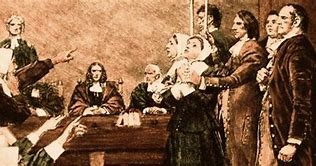
The Witch Trials of Early Modern Europe
Between 1500 and 1700 Europe was gripped by ‘witchcraze’ hysteria. Witch hunting became a gendered phenomenon which conspired mainly against women. Women who were accused of colluding with the devil, were trialled and executed under the guise of witchcraft. From a modern perspective the witch trials of Early Modern Europe can be difficult to understand. Several social, political and economic changes at the time combined forces during this period and started the persecution of witches.
A significant factor in the persecution of women in Early Modern Europe was political. The fifteenth and sixteenth centuries was a time of political upheaval with respect to the conflicts between Church and State. The conflict between Catholicism and Protestantism in Europe accelerated the movement of power from Church to the King. This upheaval resulted in unrest among common people, and accentuated superstition, as ordinary people struggled with the increasing social dysfunction. This created a climate where women who had little power could be suppressed with the threat of violence under the guise of witchcraft. In 1553 the first of the heresy laws were introduced which sought to protect the young Queen Elizabeth from malevolent forces. A second, and much harsher law, introduced in 1604 outlawed pacts between mortals and Satan (Hester 1992). These laws turned witch hunting into a phenomenon.
A second force which conspired against women was an economic one. The newly legislated ‘Enclosure Laws’ took the common lands from the poor, so that women in particular, were increasingly disempowered. Women were excluded from the labours they had traditionally used to support themselves. Men who sought to take over the practice of medicine, brewing and weaving from women could accuse women of practicing witchcraft. Poor and widowed women who were dependant on the church were often accused of witchcraft, and burnt, to rid the community of financial burden. The accusation of witchcraft became a convenient way exploit and kill women in Early Modern Europe.
The release of the book ‘Malleus Malerficarum’ (Hammer of the Witches) in 1487 also incited witchcraft mania (Sanders 1995). The influential manual, a guide for identifying witches, was constantly cited in Early Modern Europe. Heinrich Kramer, the author, asserted that women have a natural tendency for evil and malice. Kramer linked women with witches and witches to Satan resulting in a dichotomy where a battle was played out between witches and Christians and good and evil. These notions spread quickly through Europe due to the newly invented printing press.
The emergence of the witch stereotype also sustained the ‘witch craze’ hysteria. Records from the Church Courts of Canterbury as far back as 1396 saw the dark arts and black magic as the preserve of women (Briggs 1996). Due to a women’s circumstance at the time, witchcraft and heresy were seen as the only way that women could gain power. Vulnerable women who were poor, lower class, older, single, widowed or those who lived beyond the means of men were susceptible to accusations of witchcraft. Constructs of gender were influential in the persecution of women in Early Modern Europe, a phenomenon which has come to be known as gendercide.
We here at Rep-Revive Criminal & Employment lawyers have helped many people avoid criminal convictions. So if you, or someone you know, have crimila or employment legal matters, contact Rep-Revive Criminal & Employment Lawyers® for a free initial consultation on (02) 9198 1997 or visit www.rpr5.sydney for further information on how we listen, we fight, and you win! We are always in your corner!
References
Briggs, R (1996) ‘Witches and Neighbours: The Social and Cultural Context of European Witchcraft (Harper Collins).
Hester, M (1992), ‘Lewd Women and Wicked Witches : A Study in the Dynamics of Male Domination’ (London: Routledge).
Sanders, A, ‘A Deed Without a Name’: the Witch in Society and History’ (Berg Publishers LTD).
0 Comments
Post Comment